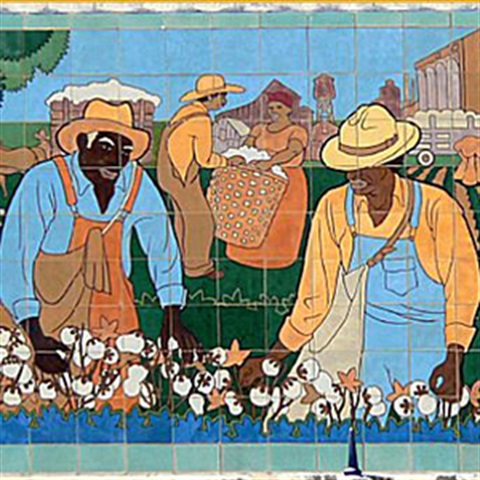
The Fort Worth Art Commission this week approved new interpretive plaques designed to foster cultural equity and provide historical context for a series of scenes depicted in murals at the Will Rogers Memorial Center.
About the artwork: Created to commemorate the Texas Centennial in 1936, two 200-foot-long, hand-painted tile murals trace the state’s settlement and industrial development. The murals were integrated into the facades of the National Register-listed Will Rogers auditorium and coliseum.
In 2019, a social media post raised concerns about the depiction of Black Texans in the auditorium mural. Alongside other agricultural workers, Black workers are depicted harvesting cotton.
The Mayor’s Office asked the Fort Worth Art Commission to seek community input and make a recommendation for responding to the concerns. Consensus emerged strongly in favor of presenting historical context for all segments of the murals.
An advisory panel recommended that permanent interpretive plaques be embedded in the plazas in front of the coliseum and auditorium. This was followed by more than two years of research and meetings with focus groups representing the diverse cultures depicted in the murals.
The goal of the project is to encourage viewers to learn more about Texas’ multifaceted history and to foster cultural equity and community understanding.
The plaque for the mosaic depicting Black fieldworkers would read:
“Use of the land and its value was changing dramatically. For the first two decades of 20th century, agriculture led the state’s economic growth. Texas produced almost one third of America’s cotton. This scene depicts tenant farming and sharecropping, systems in which freedmen, poor white, and Mexican workers farmed rented land for a share of the harvested crops. Sharecropping rarely resulted in farm ownership. After World War I (1914-1918), many laborers moved to cities for work, forcing landowners to modernize with machinery to harvest millions of acres of cotton, wheat, and other crops.”
View approved text for the other mural segments.
What’s next: City Council will be asked to consider authorizing a construction contract to fabricate, deliver and install the plaques.